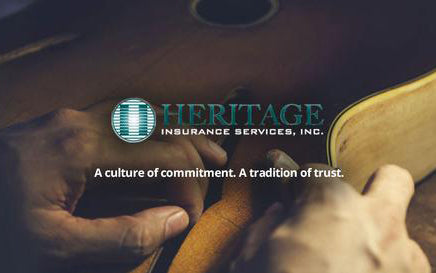
Most of our customers have not one but several high-end guitars, as well as irreplaceable vintage instruments. When asked about how they are insured, some may have added them to their home-owner’s policies.
When you consider the added cost of this type of coverage, the policy limitations, and potential exercise of having to make a claim, there is no comparison to using a company who specializes in musical instruments (guitars in particular).
Whether you have a $2m inventory as we do or just one guitar, Heritage Insurance Services, Inc. is the best and most affordable solution. We have been using them since our inception, and we ship hundreds of guitars each year. This is coverage that we count on daily. With coverage up to $20k per shipment, we also save on commercial shipping costs.
Here’s the pitch from their website…

Coverage
The Heritage Players and Collectors Policy is one of the most comprehensive and competitive policies available. Players, owners, collectors, schools, trusts, museums and even marching bands or just about any entity that owns musical instruments are eligible for coverage under this policy.
Premiums start at $200.00 per year and there are no fees or hidden charges. Policies can be written with no deductible or a $250.00 deductible or higher if you like. Coverage can be issued in a matter of minutes following receipt of our application. We offer installment payments and accept Visa, MasterCard and American Express.
The policy covers risks of direct physical loss, and it covers musical instruments worldwide. This includes but is not limited to, the following kinds of losses:
- Change in Temperature and Humidity
- Breakage and Repair including resultant loss of value
- Theft
- Fire
- Water Damage and Flood
- Windstorm, Tornado and Hail
- Earthquake
- Collision
- Vandalism
- Shipment
- Air Cargo (Baggage Check)
- Entrustment and consignment
- Dishonesty of Entrustment and consignment
- Faulty Workmanship during the repair process
And many other perils not mentioned…
What's not covered on the policy?
- Governmental confiscation or seizure
- War and Insurrection
- Nuclear Perils
- Gradual deterioration
- Wet and dry rot, Rust corrosion or mold
- Insects, worms, vermin or rodents
- Illegal Trade and transportation
- Latent Defect or inherent vice
- Consequential loss (Other than devaluation after repair)
Appraisals & Valuations
Your covered instruments and equipment will be valued at either Agreed Value, Actual Cash Value, or Replacement Cost. Here's how these [3] valuation methods work:
Agreed Value
When we accept the appraisal for an instrument and/or equipment, these items will be covered under Agreed Value Clause. The advantage of this type of valuation is that when a covered loss occurs the insurance company will not question the value of your instrument after a loss, so you are guaranteed to receive the full amount of its listed value.
Because you and the insurer agreed on the instrument's value when your policy was written (i.e., before the loss), the Agreed Value Clause enables the insurance company to pay for your loss quickly…and it ensures that you will be paid the agreed-upon amount.
Actual Cash Value
This is the more common method of valuation. If it's not practical to obtain appraisals at the time of your policy issuance, your instruments and equipment will be insured under Actual Cash Value Clause. Instead of an appraisal, you declare the value of each item to Heritage Insurance Services, Inc. This represents the market value of your items to the best of your knowledge and the amount(s) you're willing to accept in the event of a loss. The insurer then accepts these values on the condition that they're within reasonable market range.
When a loss occurs, the insurance company will either ask you to justify your declared values, or it will make the valuation directly.
Replacement Cost Valuation
When the cost to replace an instrument or related musical equipment exceeds actual cash value (fair market value) Replacement Cost may be beneficial. Some instruments and equipment physically depreciate over time. Replacement Cost is used when you prefer to be paid based on the cost to replace with new or contemporary items. As an example, say a piano has an actual cash value (fair market value) of $52,000, but is sold new by the manufacturer today for $76,000. If you insured for $76,000 under a replacement cost valuation, the insurer would pay based on the cost to replace with a new piano rather than the actual cash value of the older piano.
When an instrument appreciates or retains its value over time, replacement cost and actual cash value are the same.
The Difference[s] in a Nutshell:
- The Agreed Value Clause establishes values of your items before a loss occurs.
- The Actual Cash Value Cause requires verification of values after the loss occurs.
- The Replacement Cost clause pays based on cost to replace with a new or contemporary item or the same kind and quality.
What These Differences Mean To You:
- Instruments valued under the Agreed Cash Value Clause are always paid based upon the insured amount.
- Instruments valued under the Actual Cash Value Clause are almost always paid at the insured amount. (Take a digital picture of your instrument if you go this route.)
- As long as the insured value is within reasonable market price range, the Agreed Value and Actual Cash Value methods usually arrive at the same place, BUT you'll get there faster under the Agreed Cash Value Clause.
- Replacement cost pays based on cost to replace with a new or contemporary item or the same kind and quality.
Appraisal generally involves an independent evaluation of your instrument's value, either before or after a loss occurs, by someone other than you or the insurance company.



